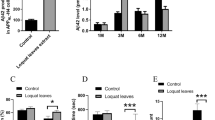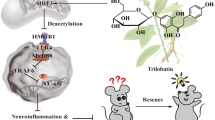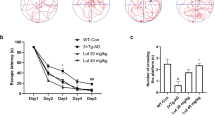Abstract
The major protein constituent of amyloid deposits in Alzheimer's disease (AD) is the amyloid β-peptide (Aβ). In the present work, we have determined the effect of hyperforin an acylphloroglucinol compound isolated from Hypericum perforatum (St John's Wort), on Aβ-induced spatial memory impairments and on Aβ neurotoxicity. We report here that hyperforin: (1) decreases amyloid deposit formation in rats injected with amyloid fibrils in the hippocampus; (2) decreases the neuropathological changes and behavioral impairments in a rat model of amyloidosis; (3) prevents Aβ-induced neurotoxicity in hippocampal neurons both from amyloid fibrils and Aβ oligomers, avoiding the increase in reactive oxidative species associated with amyloid toxicity. Both effects could be explained by the capacity of hyperforin to disaggregate amyloid deposits in a dose and time-dependent manner and to decrease Aβ aggregation and amyloid formation. Altogether these evidences suggest that hyperforin may be useful to decrease amyloid burden and toxicity in AD patients, and may be a putative therapeutic agent to fight the disease.
This is a preview of subscription content, access via your institution
Access options
Subscribe to this journal
Receive 12 print issues and online access
$259.00 per year
only $21.58 per issue
Buy this article
- Purchase on Springer Link
- Instant access to full article PDF
Prices may be subject to local taxes which are calculated during checkout







Similar content being viewed by others
References
Salmon DP, Bondi MW . The neuropsychology of Alzheimer's disease. In: Terry RD, Katzman R and Bick KL (eds). Alzheimer's Disease, 2nd edn. Raven Press: New York, 1999, pp 39–56.
Morgan C, Colombres M, Nunez MT, Inestrosa NC . Structure and function of amyloid in Alzheimer's disease. Prog Neurobiol 2004; 74: 323–349.
Yankner BA . Mechanisms of neuronal degeneration in Alzheimer's disease. Neuron 1996; 16: 921–932.
Mattson MP . Pathways towards and away from Alzheimer's disease. Nature 2004; 430: 631–639.
Cruz L, Urbanc B, Buldyrev SV, Christie R, Gomez-Isla T, Havlin S et al. Aggregation and disaggregation of senile plaques in Alzheimer disease. Proc Natl Acad Sci USA 1997; 94: 7612–7616.
Morgan C, Bugueño M, Garrido J, Inestrosa NC . Laminin affects polymerization, depolymerization and neurotoxicity of Aβ peptide. Peptides 2002; 23: 1229–1240.
Selkoe DJ . Alzheimer's disease: genes, proteins, and therapy. Physiol Rev 2001; 81: 741–766.
Bronfman FC, Garrido J, Alvarez A, Morgan C, Inestrosa NC . Laminin inhibits amyloid-β-peptide fibrillation. Neurosci Lett 1996; 218: 201–203.
Pappolla M, Bozner P, Soto C, Shao H, Robakis NK, Zagorski M et al. Inhibition of Alzheimer β-fibrillogenesis by melatonin. J Biol Chem 1998; 273: 7185–7188.
Ono K, Hasegawa K, Yoshiike Y, Takashima A, Yamada M, Naiki H . Nordihydroguaiaretic acid potently breaks down pre-formed Alzheimer's β-amyloid fibrils in vitro. J Neurochem 2002; 81: 434–440.
Ono K, Yoshiike Y, Takashima A, Hasegawa K, Naiki H, Yamada M . Potent anti-amyloidogenic and fibril-destabilizing effects of polyphenols in vitro: implications for the prevention and therapeutics of Alzheimer's disease. J Neurochem 2003; 87: 172–181.
Solomon B, Koppel R, Frankel D, Hanan-Aharon E . Disaggregation of Alzheimer β-amyloid by site-directed mAβ. Proc Natl Acad Sci USA 1997; 94: 4109–4112.
Fraser PE, Nguyen JT, McLachlan DR, Abraham CR, Kirschner DA . 1-antichymotrypsin binding to Alzheimer Aβ peptides is sequence specific and induces fibril disaggregation in vitro. J Neurochem 1993; 61: 298–305.
Luo Y, Smith JV, Paramasivam V, Burdick A, Curry KJ, Buford JP et al. Inhibition of amyloid-β-aggregation and caspase-3 activation by the Ginkgo biloba extract EGb761. Proc Natl Acad Sci USA 2002; 99: 12197–12202.
Kiuchi Y, Isobe Y, Fukushima K . Type IV collagen prevents amyloid β-protein fibril formation. Life Sci 2002; 70: 1555–1564.
Chacon MA, Barria MI, Soto C, Inestrosa NC . sheet breaker peptide prevents Abeta-induced spatial memory impairments with partial reduction of amyloid deposits. Mol Psychiatry 2004; 9: 953–961.
Singer A, Wonnemann M, Muller WE . Hyperforin, a major antidepressant constituent of St John's Wort, inhibits serotonin uptake by elevating free intracellular Na+. J Pharmacol Exp Ther 1999; 290: 1363–1368.
Klusa V, Germane S, Noldner M, Chatterjee SS . Hypericum extract and Hyperforin: memory-enhancing properties in rodents. Pharmacopsychiatry 2001; 34: S61–S69.
De Ferrari GV, Chacon MA, Barria MI, Garrido JL, Godoy JA, Olivares G et al. Activation of Wnt signaling rescues neurodegeneration and behavioral impairments induced by β-amyloid fibrils. Mol Psychiatry 2003; 8: 195–208.
Morris RGM . Developments of a water maze procedure for studying spatial learning in the rat. J Neurosci Methods 1984; 11: 47–60.
Paxinos G, Watson C . The Rat Brain in Stereotaxic Coordinates, 2nd edn. Academic Press: New York, 1986.
Côté SL, Ribeiro-Da-Silva A, Cuello AC . Immunocytochemistry II. John Wiley and Sons: New York, NY, 1993.
Reyes AE, Chacon MA, Dinamarca MC, Cerpa W, Morgan C, Inestrosa NC . Acetylcholinesterase-Aβ complexes are more toxic than Aβ fibrils in rat hippocampus: effect on rat β-amyloid aggregation, laminin expression, reactive astrocytosis, and neuronal cell loss. Am J Pathol 2004; 164: 2163–2174.
Puchtler H, Sweat F, LeVine M . On the binding of Congo red by amyloid. J Histochem Cytochem 1961; 10: 355–364.
Elghetany MT, Saleem A . Methods for staining amyloid in tissues: a review. Stain Technol 1988; 63: 201–212.
Quintanilla RA, Munoz FJ, Metcalfe MJ, Hitschfeld M, Olivares G, Godoy JA et al. Trolox and 17β-estradiol protect against amyloid β-peptide neurotoxicity by a mechanism that involves modulation of the Wnt signaling pathway. J Biol Chem 2005; 280: 11615–11625.
Muñoz FJ, Opazo C, Gil-Gómez G, Tapia G, Fernández V, Valverde MA et al. Vitamin E but not 17β-Estradiol protect against vascular toxicity induced by β-amyloid wild-type and the Dutch amyloid variant. J Neurosci 2002; 22: 3081–3089.
Pong K, Doctrow SR, Huffman K, Adinolfi CA, Baudry M . Attenuation of staurosporine-induced apoptosis, oxidative stress, and mitochondrial dysfunction by synthetic superoxide dismutase and catalase mimetics, in cultured cortical neurons. Exp Neurol 2003; 17: 84–97.
LeVine H . Thioflavin T interaction with synthetic Alzheimer's disease β-amyloid peptides: detection of amyloid aggregation in solution. Protein Sci 1993; 2: 404–410.
Naiki H, Higuchi K, Nakakuki K, Takeda T . Kinetic analysis of amyloid fibril polymerization in vitro. Lab Invest 1991; 65: 104–110.
Inestrosa NC, Alvarez A, Perez CA, Moreno RD, Vicente M, Linker C et al. Acetylcholinesterase accelerates assembly of amyloid-β-peptides into Alzheimer's fibrils: possible role of the peripheral site of the enzyme. Neuron 1996; 16: 881–891.
Pike CJ, Cummings BJ, Cotman CW . Early association of reactive astrocytes with senile plaques in Alzheimer's disease. Exp Neurol 1995; 132: 172–179.
Zhou C, Tabb MM, Sadatrafiei A, Grun F, Sun A, Blumberg B . Hyperforin, the active component of St John's wort, induces IL-8 expression in human intestinal epithelial cells via a MAPK-dependent, NF-kappaB-independent pathway. J Clin Immunol 2004; 24: 623–636.
McGeer PL, Itagaki S, Tago H, McGeer EG . Reactive microglia in patients with senile dementia of the Alzheimer type are positive for the histocompatibility glycoprotein HLA-DR. Neurosci Lett 1987; 79: 195–200.
Rozemuller JM, Eikelenboom P, Pals S, Stam FC . Microglialcells around amyloid plaques in Alzheimer's disease express leucocyte adhesion molecules of the LFA-1 family. Neurosci Lett 1989; 101: 282–292.
Hunt EJ, Lester CE, Lester EA, Tackett RL . Effect of St John's Wort on free radical production. Life Sci 2001; 69: 181–190.
Beckman JS, Koppenol WH . Nitric oxide, superoxide, and peroxynitrite: the good, the bad, and ugly. Am J Physiol 1996; 271: C1424–C1437.
Alvarez AR, Godoy JA, Mullendorff K, Olivares GH, Bronfman M, Inestrosa NC . Wnt-3a overcomes β-amyloid toxicity in rat hippocampal neurons. Exp Cell Res 2004; 297: 186–196.
Barger SW, Horster D, Furukawa K, Gogdman Y, Krieglstein J, Mattson MP . Tumor necrosis factors α and β protect neurons against amyloid β-peptide toxicity: evidence for involvement of a kappa B-binding factor and attenuation of peroxide and Ca2+ accumulation. Proc Natl Acad Sci USA 1995; 92: 9328–9332.
Butterfield DA . Amyloid β-peptide [1–42]-associated free radical-induced oxidative stress and neurodegeneration in Alzheimer's disease brain: mechanisms and consequences. Curr Med Chem 2003; 10: 2651–2659.
Miranda S, Opazo C, Larrondo LF, Munoz FJ, Ruiz F et al. The role of oxidative stress in the toxicity induced by amyloid β-peptide in Alzheimer's disease. Prog Neurobiol 2000; 62: 633–648.
Hardy J, Selkoe DJ . The amyloid hypothesis of Alzheimer's disease: progress and problems on the road to therapeutics. Science 2002; 297: 353–356.
Hoshi M, Sato M, Matsumoto S, Noguchi A, Yasutake K et al. Spherical aggregates of β-amyloid (amylospheroid) show high neurotoxicity and activate tau protein kinase I/glycogen synthase kinase-3β. Proc Nat Acad Sci 2003; 100: 6370–6375.
Selkoe DJ . The cell biology of beta-amyloid precursor protein and presenilin in Alzheimer's disease. Trends Cell Biol 1998; 8: 447–453.
Walsh D, Klyubin I, Fadeeva J, Cullen W, Anwyl R, Wolfe M et al. Naturally secreted oligomers of amyloid β protein potently inhibit hippocampal long-term potentiation in vivo. Nature 2002; 416: 53–539.
Nilsberth C, Westlind-Danielsson A, Eckman CB, Condron MM, Axelman K, Forsell C et al. The ‘Arctic’ APP mutation (E693G) causes Alzheimer's disease by enhanced Aβ protofibril formation. Nat Neurosci 2001; 4: 887–893.
Wang HW, Pasternak JF, Kuo H, Ristic H, Lambert MP et al. Soluble oligomers of β amyloid (1–42) inhibit long-term potentiation but not long-term depression in rat dentate gyrus. Brain Res 1999; 924: 133–140.
Harper JD, Wong SS, Lieber CM, Lansbury Jr PT . Assembly of Aβ amyloid protofibrils: an in vitro model for a possible early event in Alzheimer's disease. Biochemistry 1999; 38: 8972–8980.
Nielsen EH, Nybo M, Svehag SE . Electron microscopy of prefibrillar structures and amyloid fibrils. Methods Enzymol 1999; 309: 491–496.
Cummings BJ, Su JH, Cotman CW . Neuritic involvement within bFGF immunopositive plaques of Alzheimer's disease. Exp Neurol 1993; 124: 315–325.
Satoskar RR, Shah SJ, Shenoy SG . Evaluation of anti-inflammatory property of curcumin (diferuloyl methane) in patients with postoperative inflammation. Int J Clin Pharmacol Ther Toxicol 1986; 24: 651–654.
Fujisawa S, Atsumi T, Ishihara M, Kadoma Y . Cytotoxicity, ROS-generation activity and radical-scavenging activity of curcumin and related compounds. Anticancer Res 2004; 24: 563–569.
Yang F, Lim GP, Begum AN, Ubeda OJ, Simmons MR, Ambegaokar SS et al. Curcumin inhibits formation of amyloid-β oligomers and fibrils, binds plaques, and reduces amyloid in vivo. J Biol Chem 2005; 280: 5892–5901.
van Dongen M, van Rossum E, Kessels A, Sielhorst H, Knipschild P . Ginkgo for elderly people with dementia and age-associated memory impairment: a randomized clinical trial. J Clin Epidemiol 2003; 56: 367–376.
Stackman RW, Eckenstein F, Frei B, Kulhanek D, Nowlin J, Quinn JF . Prevention of age-related spatial memory deficits in a transgenic mouse model of Alzheimer's disease by chronic Ginkgo biloba treatment. Exp Neurol 2003; 184: 510–520.
Rezai-Zadeh K, Shytle D, Sun N, Mori T, Hou H, Jeanniton D et al. Green tea epigallocatechin-3-gallate (EGCG) modulates amyloid precursor protein cleavage and reduces cerebral amyloidosis in Alzheimer transgenic mice. J Neurosci 2005; 25: 8807–8814.
Marambaud P, Zhao H, Davies P . Resveratrol promotes clearance of Alzheimer's disease amyloid-β peptides. J Biol Chem 2005; 280: 37377–37382.
Oddo S, Caccamo A, Shepherd JD, Murphy MP, Golde TE, Kayed R et al. Triple-transgenic model of Alzheimer's disease with plaques and tangles: intracellular Aβ and synaptic dysfunction. Neuron 2003; 39: 409–421.
Behl C, Davis JB, Lesley R, Schubert D . Hydrogen peroxide mediates amyloid-β-protein toxicity. Cell 1994; 77: 817–827.
Walsh DM, Lomakin A, Benedek GB, Condron MM, Teplow DB . Amyloid β-protein fibrillogenesis. Detection of a protofibrillar intermediate. J Biol Chem 1997; 272: 22364–22372.
Cui Y, Gurley B, Ang C, Leakey J . Determination of hyperforin in human plasma using solid-phase extraction and high-performance liquid chromatography with ultraviolet detection. J Chromatogr B 2002; 780: 129–135.
Kiewert C, Buchholzer ML, Hartmann J, Chatterjee SS, Klein J . Stimulation of hippocampal acetylcholine release by hyperforin, a constituent of St John's Wort. Neurosci Lett 2004; 364: 195–198.
Froestl B, Steiner B, Muller WE . Enhancement of proteolytic processing of the β-amyloid precursor protein by hyperforin. Biochem Pharmacol 2003; 66: 2177–2184.
Cott JM, Rosenthal N, Blumenthal M . St John's wort and major depression. J Am Med Assoc 2001; 286: 42–45.
Xu Y, Ku BS, Yao HY, Lin YH, Ma X et al. Antidepressant effects of curcumin in the forced swim test and olfactory bulbectomy models of depression in rats. Pharmacol Biochem Behav 2005; 82: 200–206.
Butterweck V . Mechanism of action of St John's wort in depression: what is known? CNS Drugs 2003; 17: 539–562.
Rojas P, Rojas C, Ebadi M, Montes S, Monroy-Noyola A, Serrano-Garcia N . EGb761 pretreatment reduces monoamine oxidase activity in mouse corpus striatum during 1-methyl-4-phenylpyridinium neurotoxicity. Neurochem Res 2004; 29: 1417–1423.
Huang SH, Duke RK, Chebib M, Sasaki K, Wada K, Johnston GA . Ginkgolides, diterpene trilactones of Ginkgo biloba, as antagonists at recombinant α1β2γ2L GABAA receptors. Eur J Pharmacol 2004; 494: 131–138.
Albert D, Zundorf I, Dingermann T, Muller WE, Steinhilber D, Werz O . Hyperforin is a dual inhibitor of cyclooxygenase-1 and 5-lipoxygenase. Biochem Pharmacol 2002; 64: 1767–1775.
Smith JV, Luo Y . Elevation of oxidative free radicals in Alzheimer's disease models can be attenuated by Ginkgo biloba extract EGb 761. J Alzheimers Dis 2003; 5: 287–300.
Feisst C, Werz O . Suppression of receptor-mediated Ca2+ mobilization and functional leukocyte responses by hyperforin. Biochem Pharmacol 2004; 67: 1531–1539.
Yao ZX, Han Z, Drieu K, Papadopoulos V . Ginkgo biloba extract (Egb 761) inhibits β-amyloid production by lowering free cholesterol levels. J Nutr Biochem 2004; 15: 749–756.
Bastianetto S, Ramassamy C, Dore S, Christen Y, Poirier J, Quirion R . The Ginkgo biloba extract (EGb 761) protects hippocampal neurons against cell death induced by β-amyloid. Eur J Neurosci 2000; 12: 1882–1890.
Luo Y, Smith JV, Paramasivam V, Burdick A, Curry KJ et al. Inhibition of amyloid-β aggregation and caspase-3 activation by the Ginkgo biloba extract EGb761. Proc Natl Acad Sci USA 2002; 99: 12197–12202.
Acknowledgements
We thank Joselyn Mauna and Rocio Artigas for their help with the glial and microglial studies. This research was supported by grants from FONDAP (No 13980001) and the Millennium Institute for Fundamental and Basic Biology (MIFAB).
Author information
Authors and Affiliations
Corresponding author
Rights and permissions
About this article
Cite this article
Dinamarca, M., Cerpa, W., Garrido, J. et al. Hyperforin prevents β-amyloid neurotoxicity and spatial memory impairments by disaggregation of Alzheimer's amyloid-β-deposits. Mol Psychiatry 11, 1032–1048 (2006). https://doi.org/10.1038/sj.mp.4001866
Received:
Revised:
Accepted:
Published:
Issue Date:
DOI: https://doi.org/10.1038/sj.mp.4001866
Keywords
This article is cited by
-
Hypericum perforatum: a comprehensive review on pharmacognosy, preclinical studies, putative molecular mechanism, and clinical studies in neurodegenerative diseases
Naunyn-Schmiedeberg's Archives of Pharmacology (2024)
-
Reduced TRPC6 mRNA levels in the blood cells of patients with Alzheimer’s disease and mild cognitive impairment
Molecular Psychiatry (2018)
-
Tetrahydrohyperforin prevents cognitive deficit, Aβ deposition, tau phosphorylation and synaptotoxicity in the APPswe/PSEN1ΔE9 model of Alzheimer's disease: a possible effect on APP processing
Translational Psychiatry (2011)
-
Profiling of hypothalamic and hippocampal gene expression in chronically stressed rats treated with St. John’s wort extract (STW 3-VI) and fluoxetine
Psychopharmacology (2011)
-
Antidepressants are a rational complementary therapy for the treatment of Alzheimer's disease
Molecular Neurodegeneration (2010)



